
 |
Short Wing Cutey |
Here's an example of a super early pirep from yours
truly. Around 1972. In those days magazines had very few pages alotted
for color. The big ones had four pages in a middle series of pages
and that was it. If you look through some of the other Airbum pireps
you'll see photos that you'd kill for them to be color, but they aren't
because those pix fell on pages other than the middle form. They are
usually conversions of color slides to black and white and they suffered
in the process. In the case of the little Clipper, I probably shot
it in both black and white AND color, a quaint way of doing things
in today's digital age. Anyway, read on for some 35-year-old- prose
from a 30-year-old-writer. Wow! Was I ever that young? Chronologically speaking, the Clipper falls between the Vagabond (what a neat name for a Sunday pilot's airplane) and the Pacer. In the true Piper tradition of design-stretch-redesign-add-subtract-shrink-modify, the Clipper owes most of its lines to the Vagabond and most of its imagination to the J-3. It was built for one short year, 1949, after which it received a 125-hp Lycoming in place of its 115-hp 0-235, its little control sticks were replaced by wheels, and it was renamed Pacer. But it was still a Clipper (or was it a Vagabond) . When the gear Vs were turned around and a nosewheel added, the model airplane look disappeared, and the Clipper/Pacer gave birth to a bastard child, the Tri-Pacer.
With a span under 30 feet and a length of 20 feet, the mileage logged doing a preflight is mighty small. Coincidentally, the wing panels are exactly the same (except for attach points) as a Clipped Cub. When a Cub is clipped for aerobatics, one bay, 40½ inches, is removed from the inboard end of the wing, which makes the ailerons nearly full span. The Clipper has these long ailerons. Which came first, the Clipped Cub or the Clipper (I wonder if the name is significant) ? The wings carry their primary loads through aluminum spars and beefy
struts, but the air loads are carried through the fabric into built-up
aluminum ribs. A popular conversion is replacing the fabric with light
gauge aluminum. There is an STC for this conversion and helps
eliminate that awful ache in the budget every seven years or so. (Ed
note: you'd never do that today.) |